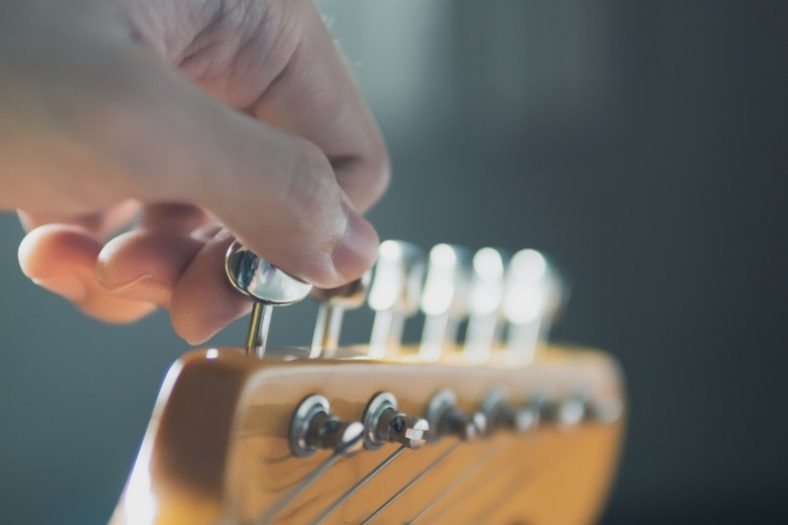DGCFAD Tuning (How to, Songs, Where to Use It)

D standard is but one of the many alternative guitar tunings. It’s called ‘D’ because it’s tuned to D instead of E, and it’s still called ‘standard’ because it has the same pitch divisions that you’d find in an E standard tuning – a D standard is just an E standard tuned one whole step down.
The standard tuning of a guitar can be changed to many alternative tunings. A guitar tuning is merely a given assignment of pitches to a guitar’s open strings. In standard tuning, guitars are tuned in EADGBE, going from the lowest pitch (the thickest string) to the highest (the thinnest string).
Let’s take a more in-depth look into the D standard.
Contents
Why use the D standard tuning?
All alternative guitar tunings are fun to play with, but the D standard is particularly popular for two reasons. For one, it produces a heavier sound that’s commonly used in genres such as metal and stoner rock. Second, it plays like an E standard tuning, meaning anyone can easily adapt to it.
The chords you’ve worked so hard to learn on the guitar will all still function the same way in the D standard tuning, with the exception they’ll be one whole step below. This means there’s no learning curve for playing in D standard tuning.
So, what’s the D standard tuning?
If the standard tuning is EADGBE, the D standard is DGCFAD. You can always remember the D standard tuning by memorizing the standard tuning (mnemonics can help) and knowing that the D standard is the same, but one whole step below.
How to tune DGCFAD?
To tune DGCFAD, just grab your guitar and tune every string down by one whole step. If you’re an experienced musician, you can do it by ear. Completing music-interval identification quizzes is a great way to enhance this ability. Remember that a whole step interval is also known as a Major 2nd.
If you can easily recognize a Major 2nd (i.e., two semitones) interval, you should be able to tune a guitar from standard to D standard. Naturally, there are different, more exact ways to tune a guitar. You can use an electronic hardware tuner, a piano, a tuning fork, or an online tool such as an app, website, or video. Here’s more on how to tune an electric guitar.
Keep in mind that, just like EADGBE, DGCFAD is also tuned from the lowest pitch to the highest pitch. If you’re tuning an un-tuned guitar to D standard from scratch, it helps to know that the lowest open string D is a D3 (the third D on piano, counting from the lowest note) and the highest open string D is a D4 (the fourth D on piano).
Anytime you use a lower, beefier guitar tuning, your guitar strings will feel looser. This means that the strings will not be as tense as usual, which can affect your playing. For this reason, using heavier gauge guitar strings for playing in D standard is advised.
Why use heavier gauge guitar strings?
Heavier gauge guitar strings are thicker, meaning they hold more tension. This means they’re more convenient for strumming, especially if you’re using an alternative, lower guitar tuning such as D standard. The one downside is that thicker strings are a bit harder to bend.
Artists/Bands who use DGCFAD tuning
The D standard is a very powerful guitar tuning, but what is it that makes it so special? Arguably the second-most common guitar tuning (apart from standard tuning), the D standard was and still is used extensively in heavier, darker genres of music, spanning from post-punk and stoner rock to metal.
There are so many artists and rock bands that make use of the DGCFAD tuning that’s impossible to list them all; Metallica, GHOST, Mastodon, Dream Theater, or Children of Bodom are just some examples. Closer to doom and gothic rock, the American singer-songwriter Chelsea Wolfe also uses the D standard recurrently.
Songs with DGCFAD tuning
Here are a few example songs of the DHCFAD tuning:
Mastodon – Blood and Thunder
The American heavy metal band Mastodon loves the D standard tuning, which is the basis of some of their best-known songs. A fan of the band from Atlanta, Georgia even covered some of their D-standard tunes—such as “Naked Burn”—in a medley video. It’s a great way to get your ear around the D standard sound.
Nirvana – Come As You Are
Possibly one of the most popular rock songs in D standard, Nirvana’s “Come As You Are” is a great song to play if you’re trying to learn alternative guitar tunings. The classic chorused guitar line in the song goes to show that the D standard can also sound eerie, without being necessarily heavy and beefy.
Metallica – Seek and Destroy
Metallica’s contagious “Seek and Destroy” features one of the catchiest riffs in metal, and it’s all D standard. They have many other songs by Metallica in D standard, including “Sad But True,” “The Thing That Should Not Be,” and “Sabbra Cadabra.”
Blink-182 – Adam’s Song
Just like Nirvana’s “Come As You Are,” Blink-182’s “Adam’s Song” makes use of the eeriness of the D standard tuning to create a song that’s catchy but also strangely dark.
George Ezra – Budapest
Outside of rock and punk music, it’s worth noting that the hit song “Budapest,” by George Ezra, is also played using the D standard. It goes to show that D-standard tunes don’t necessarily have to be dark and eerie; they can also be playful and joyful.
Other Alternative Guitar Tunings
Apart from standard tunings, in which you tune the guitar strings one or more whole steps down and above according to the EADGBE pitch division, popular alternative guitar tunings include dropped tunings and open tunings.
What are dropped tunings?
Dropped tunings are also very popular among rock musicians, and they’re different from standard guitar tunings because only one string (typically, the lowest E) is tuned down. Drop D is different from the D standard because, in Drop D, only the lowest guitar string is tuned one whole step down.
It’s easy to mistake the Drop D for the D standard because both are recurrently used by metal/heavy rock artists. There are many categories of dropped tunings, including Drop B (check some songs in Drop B here) and Drop C (used in songs such as System of a Down’s “Chop Suey!”).
What are open tunings?
Open tunings are alternative guitar tunings that allow the musician to play a chord simply by strumming the open strings of a guitar. In other words, you don’t need to touch the fret to produce a chord. These guitar tunings are very useful for songs that rely heavily on one chord, with no to few variations.
The downside of open tunings is that they’re not as versatile as standard tunings. However, if you plan on doing an entire show in one key, for instance, they can make your job as a guitar player a lot easier. These are some of the best songs that use Open D tuning.
Conclusion
You can do a lot with the standard tuning of a guitar, but playing around with alternative tunings is a must-do if you plan on developing your skills and know-how as a musician. If you’re a fan of heavy rock music or like to experiment with new sounds, just tune your guitar to DGCFAD and have some fun!





